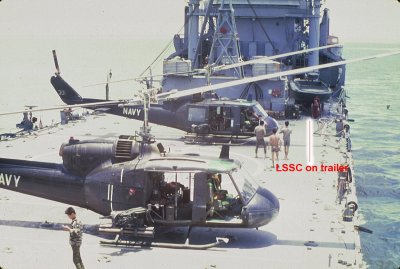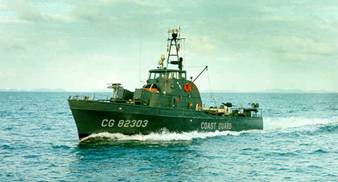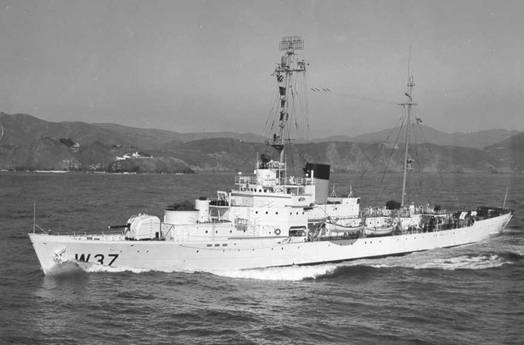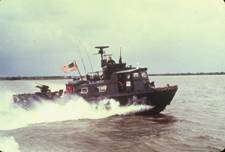How Detachment ECHO Got Its LSSC to SEA FLOAT (and it’s LCPL)
By Robert Stoner, GMCM (SW) (Ret)
© 2005 Robert H. Stoner – used by permission
![]()
It all started innocently enough. I received a batch of photos from Jim Gray, GMCM (CC) (Ret). Before he retired, Jim had put together a collection of slides from various sources to give personnel newly assigned to Special Boat Unit TWELVE a look at their past history. I had the photos digitized and sent the slides back to Jim.
One of the photos showed a pair of UH-1B “Seawolf” gunship helicopters on the deck of a tank landing ship (LST) with several Navy PCF “Swift” boats tied-up alongside. Such scenes were common for LSTs supporting Operations MARKET TIME (CTF-115) and GAME WARDEN (CTF-116). What was not common was the LSSC parked on the deck of the LST behind a CO2 fire bottle (right, behind the rear UH-1B).
There were a couple of clues that helped me get started tracking down the story. First, the UH-1B helicopters had the M-6 armament suite (four M-60s plus two rocket pods) instead of the M-21 armament suite (two M-134 Mini-guns plus two rocket pods). That meant the photo was taken before the Spring of 1970 (this from Mike Dobson of HA(L)-3).
Second, the LST was part of the LST-1156 class built in 1952 and not part of over one thousand built for World War 2. The LSTs of this class were assigned to Amphibious Ready Groups ALPHA and BRAVO. Group ALPHA worked around Da Nang and Group BRAVO supported the Mobile Riverine Force (CTF-117) in the Mekong River and Operation SEA FLOAT (later SOLID ANCHOR) on the Ca Mau Peninsula.
Third, the water was blue and not brown. Since I’d operated with both CTF-116 and CTF-117, I knew immediately it was not with the Mobile Riverine Force. The waters of the Mekong were brown and PCFs were not used in this operations area. Therefore, it had to be connected with early SEA FLOAT operations. The question was how? Inquiries were sent to various parties, but at first there were no results. Then, Jim Gray was able to give me a lead:
“Bob, just quickly. [photo] Taken by OIC John Engstrom, Det. ECHO [in the] 1969 move [of] the Det. into the Nam Cam area. They were the first Det. to operate there. Boats were an LSSC and LCPL. Best Regards, Jim G.”
From that information I was able to trace the LSTs that might have carried the LSSC. I forwarded all of this information to Bill Bremer. Bill was able to contact former members of Detachment ECHO, Bruce Roberts and Dave Dyer. Dave Dyer was able to provide the rest of the story on the LSSC:
“Bill and Bruce, Dave Dyer here.
In June of 1969 I was in Binh Thuy getting ready to go to SEA FLOAT. We took one LCPL (the old “Blackpower”) and one LSSC to Vung Tau.
We towed the LSSC behind the LCPL from Binh Thuy past Dung Island to the open sea. (There weren’t any SEALs or MST there at this time.)
When we hit the sea, we went east until we hit blue water, and then north towards Vung Tau. The seas were rough, and we could not make any headway. The Coast Guard cutter POINT GRACE [WPB 82323] took us in-tow. The cutter towed the “Blackpower” [LCPL] and the “Blackpower” towed the LSSC. The towline from the cutter got tangled in her screws.
I was on the “Blackpower” when the line got cut. I was left out at sea (it was too rough to try a new line), bouncing between the waves. The LSSC in tow would disappear between the waves and the line would go taught and then go slack. The line went slack and then never tightened-up. The LSSC was M[issing] I[n] A[ction]. I was too young and dumb to realize that I was MIA also.
The seas calmed the next day. The “Blackpower” and I were found floating at sea. It took two days to find the LSSC. After about a week at Vung Tau, the WINDHAM COUNTY (LST-1170) took the LSSC around the tip of Vietnam to offload at Square Bay [the western entrance to the Song Cau Lon and SEA FLOAT]. It took about three weeks before the rest of Det. ECHO got there with [the LCPL] “Blackpower.” Once we got it together, it was almost all operations from July [19]69 to CONUS [December 1969]. The SEALs and MST were not stationed on the WINDHAM COUNTY.”
Soon after I got Dave’s story of the LSSC, Bruce Roberts, Det. ECHO’s former OIC provided even more details on the tale of the LSSC and the LCPL.
“As to the tow from Binh Thuy: When I took over Det. ECHO in late June, [19]69, the [LC]PL was on a trailer at Binh Thuy. [It was] being repaired after a serious altercation with the natives down on the Rach Ong Dinh. We also had a dead LSSC there [Binh Thuy]. About mid-July, LT Tom Mason, the senior officer in-country, told me to get my boats south and start operations ASAP. Understandable, but the PL wasn’t really ready. I squawked, but [I] lost.
The plan was that I would tow the LSSC down the Bassac [River] and rendezvous with a Coast Guard 82-footer, the POINT GRACE, at the [river] mouth. We stocked up on everything, including maxing out our beer rations, since we were headed for the middle of nowhere. The 82-footer was supposed to “daisy chain” tow us 150 miles south, and then we were to run in [to SEA FLOAT] through the [Song] Bo De. Sure enough, we joined up with her [POINT GRACE] and she took us in-tow.
The PL had her V-drive locked to keep the shaft from rotating. This was to cause us grief later. Anyway, the cutter towed the PL and the LSSC (number 13, I think) was tied on behind us, unmanned.
Things got off to a bad start. First, the 82-footer turned too close to some fish stakes. We swung the PL clear, but the LSSC drifted into them. Strike one. Strike two happened that night, when we ran into a storm.
We were checking the LSSC every twenty minutes or so with a flashlight. Finally [RM2 Wayne] Baum came forward and reported we’d lost it. I called the Coast Guard and requested they heave-to while we looked for it. While we and they were flashing lights around, we began to drift toward them, and their CO asked me to stand clear. Unfortunately our shaft was locked, so I suggested he stand clear of us. He replied that the towline had fouled his screws. The upshot is that I [LCPL] drifted into him energetically enough to punch five holes in his [the cutter’s] side. In the meantime, I was about as seasick as I ever hope to be.
I boarded the cutter for a “council of war” on finding the LSSC, [and] then [found out I] couldn’t jump back down to the pitching PL. I finally just lay down by the rail in the rain and continued my experiments into whether it was possible to die of seasickness. (It isn’t . . . I tried.) We were “rescued” by the USCG cutter SPENCER [WHEC-36], later that night, although I lost a .50 going alongside her. She took us to Cat Lo, where we spent a few days, while the coasties decided whether to keelhaul me or just settle for a nice hanging. The LSSC was found a day or so later by a merchantman.”
[The LSSC wound-up getting to SEA FLOAT on the USS WINDHAM COUNTY. However, the LCPL would make the trip to SEA FLOAT under tow. This time it was by a PCF “Swift” boat.]
“We finally headed south again in-tow, and were proceeding nicely, in beautiful weather, when I glanced up and saw water coming over our bow. We were sinking! I called the Swift and asked [her] to heave-to (this was getting to be awfully repetitious) and [to] send us a P-250 pump. I went down into the compartment forward of the conn – [there was] no water. Then, I noticed that the manhole cover over the peak tank was ajar. Sure enough, we’d been taking water over the bow for some time, and it had gradually filled the compartment. I went in with a helmet to bail, until we got a pump aboard. With that squared away, we then went on our way, around the tip of the Ca Mau [Peninsula] and up the Gulf of Thailand to Square Bay.
[We sailed] up the [Song] Cua Lon to base [SEA FLOAT], where we were promptly chewed out for: (1) causing a major panic by coming-in unannounced — got to watch those infiltrating VC LCPL’s — and (2) we tied-up in the wrong spot. Oh, well, you can’t win ’em all . . .
Well, Bob, you now know the full story of our excursion to SEA FLOAT.”
Epilogue. When I started researching the story behind the LSSC, I had no idea of the problems Det. ECHO had in getting its two boats to support SEAL operations at SEA FLOAT. Much of the Navy’s operations in Viet Nam resembled the campaigns fought along the coasts and inland waterways of the United States during the Civil War years of 1861 to 1865. Much had been forgotten in the intervening century. Much of the Navy’s (and Coast Guard’s) role was done on an ad hoc basis and there was a great deal of trail and error involved to get all the pieces of the puzzle in place. The problems faced by LT Bruce Roberts and the members of Det. ECHO are typical of the challenges the MST detachments met and overcame to accomplish their mission of supporting the Navy’s SEAL teams.
There are lots of reasons why the Navy had a hard time shifting gears when it went from a “haze gray and underway” deep water Navy to a “green and shallow” brown water force. First, the Navy’s focus had been the fleet and power projection from the sea since the end of World War 2 and the start of the Cold War. Second, command of a ship at sea or squadron had been the advancement path for officers. Third, the limited war represented by the coasts, rivers, and canals of Viet Nam were 180 degrees from the first two.
In Viet Nam, enlisted petty officers – sometimes second class, but usually first class and chiefs – skippered the small craft on the rivers and canals. Junior officers ran the coast patrols on the PCF’s, cutters, and junks. It wasn’t like commanding a destroyer, a cruiser, or a carrier. It was better than that; it was hands-on seamanship at its most basic and rewarding. It was small boats, with small crews, and lots of responsibility.
Until the training caught up to the reality, much of the training was done on the job, in the Viet Nam combat zone. LT Bruce Roberts remarked about this reality when he was reviewing my article:
“Thanks for your note. . . I’m frankly a bit embarrassed at the way that whole mess must look, especially those parts that I was responsible for, but that’s pretty much the way it was.
By the way, you might be interested to know that prior to deployment, I had driven small craft exactly once (a Mk I Swift in San Diego harbor) and ridden two other boats once each on the basis of ‘look but don’t touch anything!’ So much for training.”
My response paralleled Bruce’s experience:
“Actually, your experiences are pretty typical. The Navy is no different that any other large organization — it tends to succeed in spite of itself. My small boat experience was pretty much as yours was — on the job training [in February to May of 1970].”
“I did some PTF training on the -13 boat in Coronado (I even got to drive once or twice). No training at all on the LSSC other than: “This is an LSSC. Look at it. Remember it. Next boat.”
“We got LCPL training (backing out from the pier and landing at the pier). We did some training on the MSSC and we got some experience driving an LCM-6 that belonged to ACU-1.”
“The LCM training was a hoot — I don’t know how we didn’t manage to broach the boat in the surf because somebody had mixed-up the props and had installed two of the same kind. She turned great in one direction only! Backing up (and not broaching) was a VERY interesting feat.”
“As it turned out, we had a couple of good boat drivers attached with us — BM2 Moore, BM1 Butler, RM2 Wallace, and RD2 Wells — so the rest of us did the other jobs on the boats and helped out on long transits.”
Below are representative pictures of the Coast Guard vessels and PCF involved during the attempts to reach SEA FLOAT under tow.
The 82-foot cutter POINT YOUNG (WPB 82303) was a sister craft to the POINT GRACE (WPB 82323). These and other 82-foot USCG units were assigned to Coastal Divisions 11, 12, and 13 of Coastal Squadron ONE as part of Operation MARKET TIME (CTF-115). Both POINT GRACE and POINT YOUNG were part of the 26 cutters turned over to the Vietnamese by December 1970. (Photo: USCG)
Coast Guard high endurance cutter TANEY (WHEC-37) off the California coast about 1963. The USCG cutter SPENCER (WHEC-36) was a sister ship to TANEY. These 327-foot cutters were part of a class of seven built in 1936. The USCG cutter HAMILTON was torpedoed by a U-boat and lost in World War 2. The remaining sisters had long, distinguished service lives and all served one deployment to Viet Nam as part of Operation MARKET TIME (CTF-115). Of the class, cutters TANEY (WHEC-37) and INGHAM (WHEC-35) survive today as museum ships. (Photo: USCG)
A Navy “Swift” boat (PCF) on patrol off the Ca Mau Peninsula near SEA FLOAT. A boat like this finished the tow of LT Robert’s LCPL to SEA FLOAT. Note the cargo net on the bow of the boat. When the PCF carried troops and SEALs, the crew rigged a cargo net over the bow to help extract them at the end of the operation. The high profile of the PCF made it a poor choice for the SEA FLOAT/SOLID ANCHOR operations area. When the crew was expecting combat action, the pilot house was vacated, the gunner put flak jackets over his legs to protect them from shrapnel, and the boat was conned from the emergency steering wheel on the port side of the deckhouse (below the US flag). The VC/NVA could [and did] accurately place a B-40 rocket into the area around the insignia on the pilot house door. If someone did not close the door to hide it, the insignia would serve as a great aiming reference. (Photo: US Navy)




